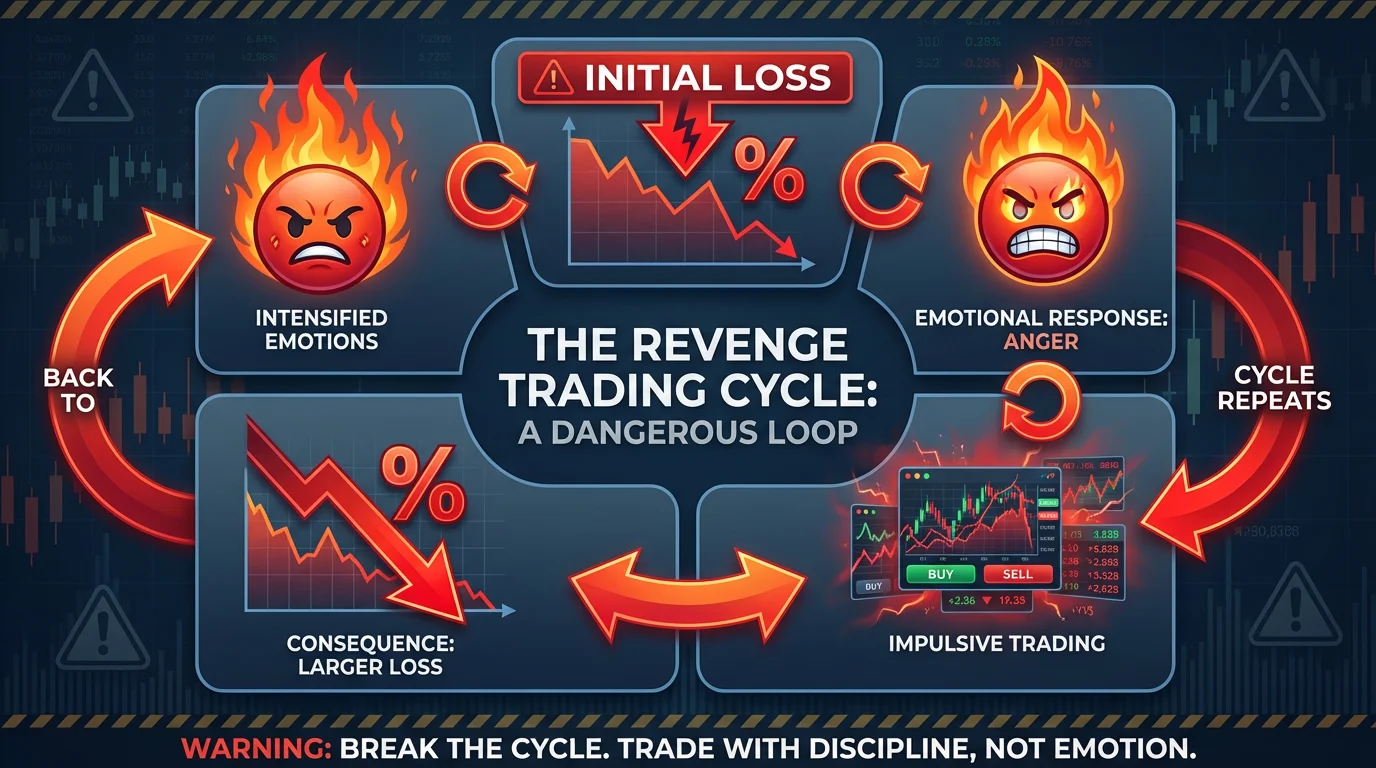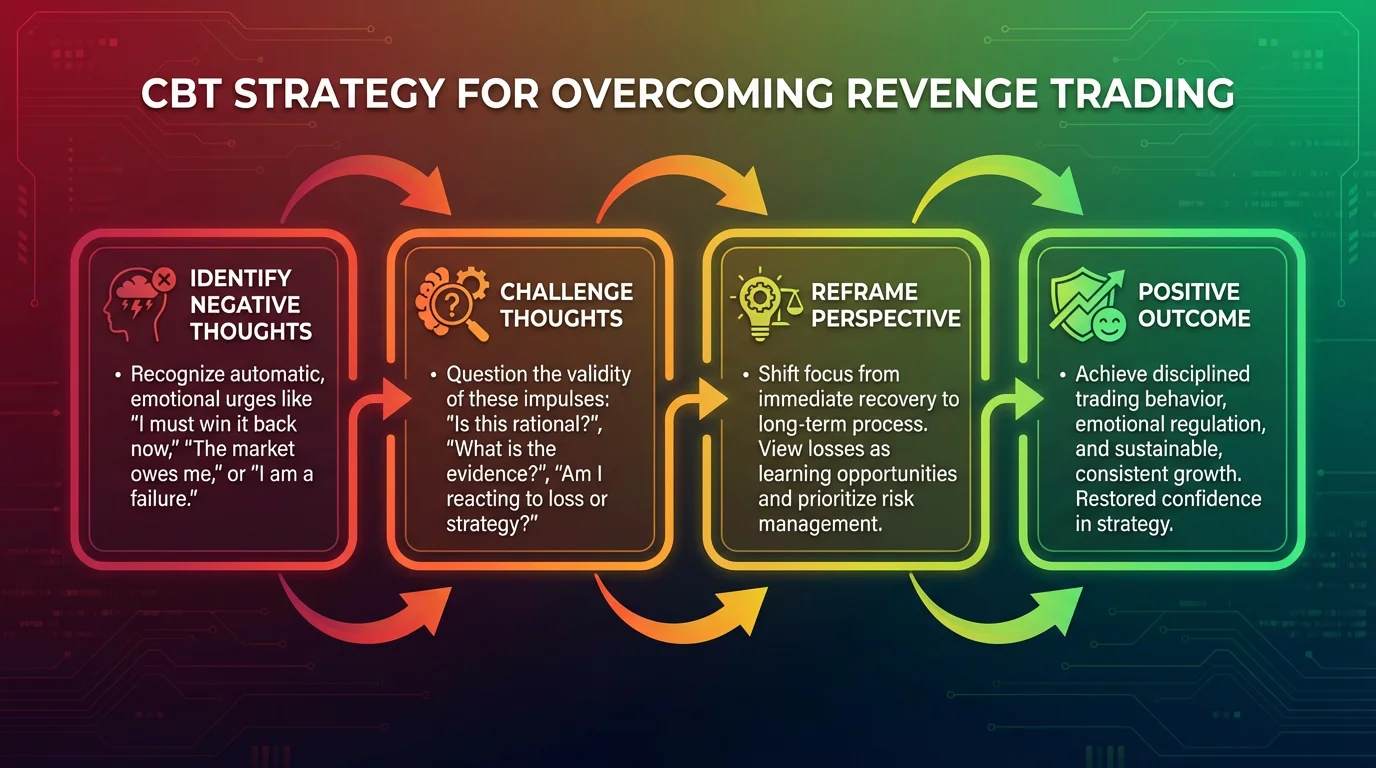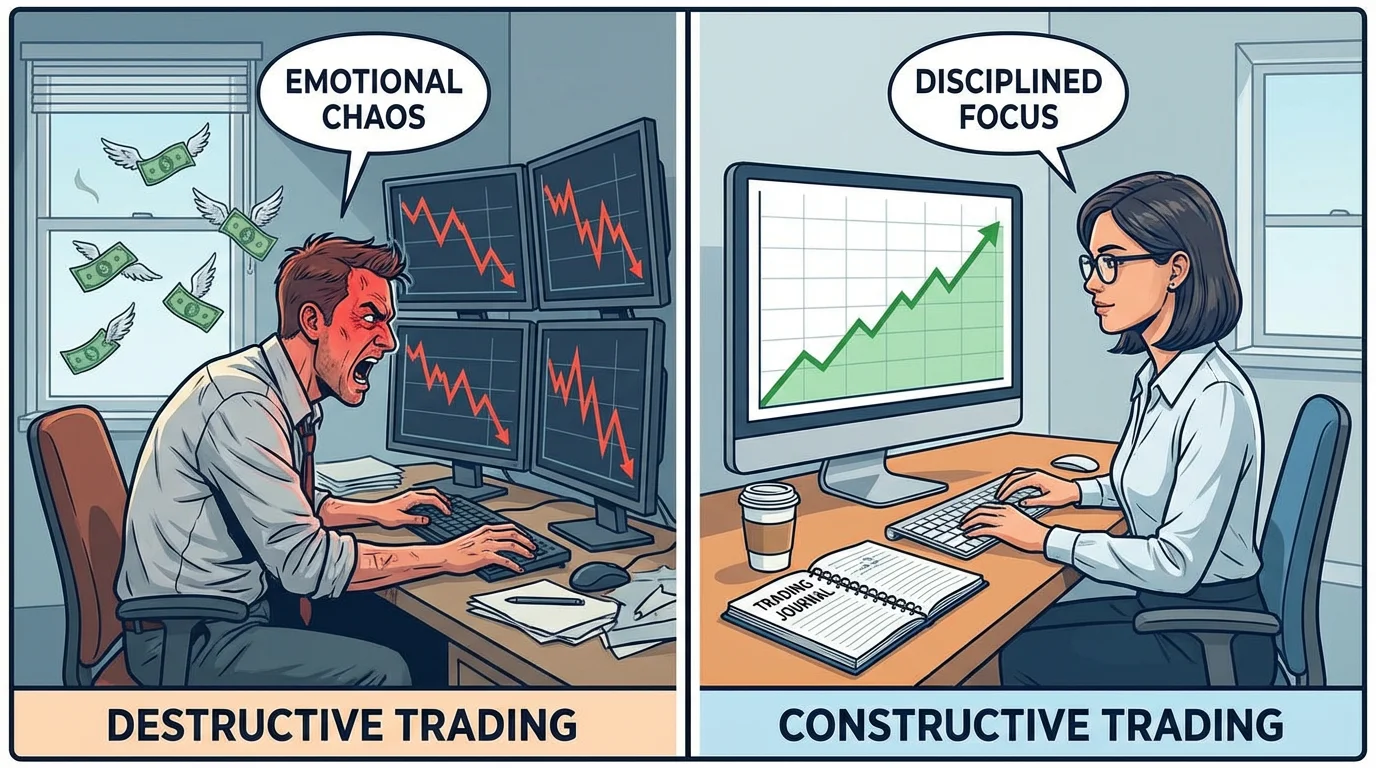In the world of Forex trading, losses are an inevitable part of the game. No matter how skilled or experienced a trader you are, you will have losing trades. However, it’s not the losses themselves that are the biggest threat to your trading account; it’s how you react to them. For many traders, a significant or unexpected loss can trigger a powerful and destructive emotional response: anger. This anger can lead to a phenomenon known as revenge trading, a dangerous and irrational behavior that can turn even the most disciplined trader into a reckless gambler. Understanding this destructive pattern and learning how to overcome it is essential for anyone who wants to build a sustainable and profitable trading career.
This article will explore the dark side of trading psychology, delving into the world of revenge trading. We will examine a story-driven case study to illustrate how quickly things can go wrong, uncover the psychological drivers behind this destructive behavior, and provide practical Cognitive Behavioral Therapy (CBT) tactics to help you regain control. Understanding and overcoming revenge trading is not just about protecting your capital; it’s about preserving your career as a trader and your mental health.
What is Revenge Trading? Understanding the Mechanics of Self-Destruction

Revenge trading is the act of entering a new trade immediately after a losing trade, with the primary goal of winning back the money you just lost. It is an emotional and impulsive reaction that is driven by anger, frustration, and a sense of injustice. When you are revenge trading, you are not following your trading plan; you are acting on a primal urge to “get back” at the market.
According to Warrior Trading, “Revenge trading is a natural, emotional response after experiencing a quick or large loss where traders will often overtrade themselves into a deeper hole”. This is a critical point: revenge trading is not a rational or strategic decision. It is a purely emotional one. You are no longer trading based on your analysis of the market; you are trading based on your desire to erase the pain of a recent loss.
The key characteristics of revenge trading include:
– Impulsivity: Entering trades without proper analysis or planning.
– Increased Position Size: Taking larger positions than usual in an attempt to quickly recover losses.
– Abandonment of Risk Management: Ignoring stop-loss orders or moving them to unrealistic levels.
– Violation of Trading Plan: Entering trades that don’t meet your normal entry criteria.
– Emotional Decision-Making: Making decisions based on emotion rather than logic.
Revenge trading is particularly dangerous because it often leads to a cascade of losses. One losing trade triggers revenge trading, which leads to another loss, which triggers more revenge trading, and so on. Before the trader realizes what’s happening, they have suffered catastrophic losses that can wipe out months or even years of profits.
A Case Study in Self-Destruction: The Story of Alex

Let’s consider the case of a fictional trader named Alex. Alex is a disciplined and experienced Forex trader who has been consistently profitable for several years. He has a well-defined trading plan, a strict risk management strategy, and a deep understanding of the market. However, one day, everything changes.
Alex enters a trade based on a high-probability setup that he has been waiting for all week. He is confident in his analysis and expects the trade to be a winner. He enters at 1.2500 with a stop-loss at 1.2450 (50 pips) and a take-profit target at 1.2600 (100 pips). His risk-reward ratio is 1:2, which aligns perfectly with his trading plan. He is trading 1 standard lot, which means his maximum risk is $500.
However, shortly after he enters the trade, the market unexpectedly reverses. A surprise economic announcement sends the price plummeting. Within minutes, Alex’s trade hits his stop-loss, and he realizes a $500 loss. Alex is stunned. He can’t believe that his “perfect” setup failed. He feels a surge of anger and frustration. He feels like the market has cheated him.
Instead of taking a break and analyzing what went wrong, Alex immediately jumps back into the market. He wants to win back his losses, and he wants to do it now. He abandons his trading plan and starts taking on reckless trades. He doubles his position size to 2 standard lots, thinking that if he can just get a quick 50-pip move in his favor, he can recover his loss. He enters a trade without proper analysis, based solely on the fact that the price has moved down and he expects a bounce.
The trade moves slightly in his favor, and Alex is excited. He’s going to recover his loss! But then the market reverses again, and his trade hits his stop-loss. Now he’s down $1,000. Instead of stopping and reassessing, Alex is even more determined to win back his money. He enters another trade, this time with 3 standard lots. He’s no longer thinking about his trading plan or risk management. He’s only thinking about recovering his losses.
Over the course of the next few hours, Alex enters and exits multiple trades, each one larger than the last. His emotions are running high – alternating between hope and despair. He’s not analyzing the market anymore; he’s just reacting to price movements. Within a matter of hours, Alex has wiped out his entire $10,000 trading account. What started as a $500 loss has turned into a complete account wipeout.
Alex’s story is a cautionary tale that illustrates the destructive power of revenge trading. It shows how quickly a single emotional reaction can undo years of hard work and discipline. More importantly, it demonstrates how revenge trading can turn a manageable loss into a catastrophic one.
The Psychology of Revenge Trading: Understanding the Drivers

To overcome revenge trading, it’s important to understand the psychological forces that drive it. At its core, revenge trading is a manifestation of several cognitive and emotional biases and psychological principles.
Loss Aversion
Loss aversion is the tendency to feel the pain of a loss more acutely than the pleasure of an equivalent gain. When you experience a loss, your brain’s natural reaction is to do whatever it takes to avoid that pain in the future. This can lead to the irrational desire to win back your losses immediately. Research by Kahneman and Tversky, the pioneers of behavioral economics, found that losses are typically felt about twice as intensely as equivalent gains.
This asymmetry in our emotional response to losses and gains can be devastating in trading. A trader who has just suffered a loss may be willing to take on significantly more risk than they normally would, simply to try to recover that loss quickly. This is exactly the opposite of what they should be doing.
The Gambler’s Fallacy
The gambler’s fallacy is the mistaken belief that if something happens more frequently than normal during a given period, it will happen less frequently in the future. After a losing trade, you may feel like you are “due” for a win. This can lead you to take on reckless trades in the belief that your luck is about to turn. However, this is a fundamental misunderstanding of probability. Each trade is an independent event, and past results do not influence future outcomes.
The Need for Closure
The human brain has a natural desire for closure. When you experience a loss, it can feel like an open loop that needs to be closed. Revenge trading is an attempt to close that loop by winning back your losses and erasing the pain of the initial loss. However, this need for closure often leads traders to make irrational decisions that make their situation worse, not better.
Ego and Self-Image
Many traders have a strong ego investment in their trading. They see themselves as skilled traders, and a loss can feel like a personal attack on their identity. This can trigger anger and a desire to prove themselves right. Revenge trading becomes a way of asserting their dominance over the market and restoring their self-image.
Cognitive Behavioral Therapy (CBT) Tactics for Overcoming Revenge Trading
Cognitive Behavioral Therapy (CBT) is a type of psychotherapy that can be highly effective in helping traders to overcome revenge trading. CBT is based on the idea that our thoughts, feelings, and behaviors are all interconnected. By changing our negative thought patterns, we can change our emotional and behavioral responses. Here are some CBT tactics that you can use to combat revenge trading:
Tactic 1: Identify Your Negative Thoughts
The first step is to become aware of the negative thoughts that trigger your desire to revenge trade. These thoughts may include things like:
– “I can’t believe I lost that trade.”
– “I have to win back my money.”
– “I’m a terrible trader.”
– “The market is against me.”
– “I need to prove that I’m right.”
– “This loss is unfair.”
Write down these thoughts as soon as you notice them. The act of writing them down helps to externalize them and makes them easier to examine objectively.
Tactic 2: Challenge Your Negative Thoughts
Once you have identified your negative thoughts, you need to challenge them. Ask yourself if these thoughts are really true. Is it really true that you are a terrible trader just because you had one losing trade? Is it really true that you have to win back your money immediately? By challenging your negative thoughts, you can start to see them for what they are: irrational and unhelpful.
For each negative thought, ask yourself:
– Is this thought based on facts or on emotions?
– What evidence do I have that this thought is true?
– What evidence do I have that this thought is false?
– What would I tell a friend who was having this thought?
– Is this thought helping me or hurting me?
Tactic 3: Reframe Your Perspective
Instead of viewing losses as a personal failure, try to reframe them as a learning opportunity. Every loss is a chance to learn something new about the market and about yourself. By reframing your perspective, you can transform a negative experience into a positive one.
For example, instead of thinking “I’m a terrible trader because I lost that trade,” you could think “That loss taught me something valuable about the market. I can use this information to improve my trading in the future.”
| CBT Tactic | Description | Application in Trading | Example |
|---|---|---|---|
| Identify Negative Thoughts | Become aware of the thoughts that trigger emotional responses. | Recognize thoughts like “I must win it back” after a loss. | “I can’t believe I lost that trade. I have to make it back immediately.” |
| Challenge Negative Thoughts | Question the validity and rationality of negative thoughts. | Ask yourself: “Does one loss define my entire trading ability?” | “Is it really true that I’m a bad trader? I’ve had many winning trades.” |
| Reframe Your Perspective | Change the way you interpret events. | View losses as feedback from the market, not as personal attacks. | “This loss is valuable information. It shows me where my analysis was wrong.” |
| Develop Coping Statements | Create positive statements to use when you feel the urge to revenge trade. | Use statements like “I trust my plan. I will wait for the next opportunity.” | “My plan is sound. One loss doesn’t change that. I will follow my plan.” |
Prevention and Recovery Strategies
In addition to using CBT tactics, there are several practical steps you can take to prevent and recover from revenge trading:
Have a Trading Plan
A well-defined trading plan is your best defense against emotional decision-making. Your plan should be detailed and specific, outlining exactly when you will and will not trade. It should include your entry criteria, exit criteria, position sizing rules, and risk management guidelines. Most importantly, you should commit to following your plan, even when emotions are running high.
Set a Daily Loss Limit
A daily loss limit is a predetermined amount of money that you are willing to lose in a single day. Once you reach your daily loss limit, you must stop trading for the day. This is a hard stop – no exceptions. By setting a daily loss limit, you can prevent a single bad trade or a series of bad trades from turning into a catastrophic loss.
For example, you might set a daily loss limit of $1,000. If you lose $1,000 in a day, you stop trading immediately, regardless of how you feel or what opportunities you see in the market.
Take a Break
If you experience a significant loss, take a break from trading. Step away from your computer, go for a walk, or do something else to clear your head. This break gives your emotions time to settle and allows you to approach the market with a fresh perspective. Many traders find that taking a break after a loss helps them to avoid revenge trading.
Keep a Trading Journal
A trading journal can help you to identify your emotional patterns and to learn from your mistakes. After each trade, write down not just the technical details of the trade, but also your emotional state before, during, and after the trade. Over time, you will start to see patterns in your emotional responses and can develop strategies to address them.
Seek Support
If you find that you are consistently struggling with revenge trading, consider seeking support from a therapist or counselor who specializes in behavioral finance or trading psychology. There is no shame in seeking professional help. Many successful traders work with mental health professionals to develop better emotional control.
Conclusion
Revenge trading is a destructive and dangerous behavior that can have devastating consequences for your trading account and your mental health. It is a purely emotional reaction that is driven by anger, frustration, and a sense of injustice. By understanding the psychology behind revenge trading and by using practical strategies like CBT, you can learn to control your emotions and to avoid the temptation to chase after your losses. Remember, the goal of trading is not to be right on every trade; it’s to be profitable over the long run. And that requires discipline, patience, and a deep respect for the power of the market. Every trader who has achieved long-term success has had to overcome the temptation to revenge trade at some point in their career. The fact that you are reading this article suggests that you are committed to breaking this destructive pattern. That commitment, combined with the strategies outlined in this article, can help you to build a more disciplined and profitable trading career.
